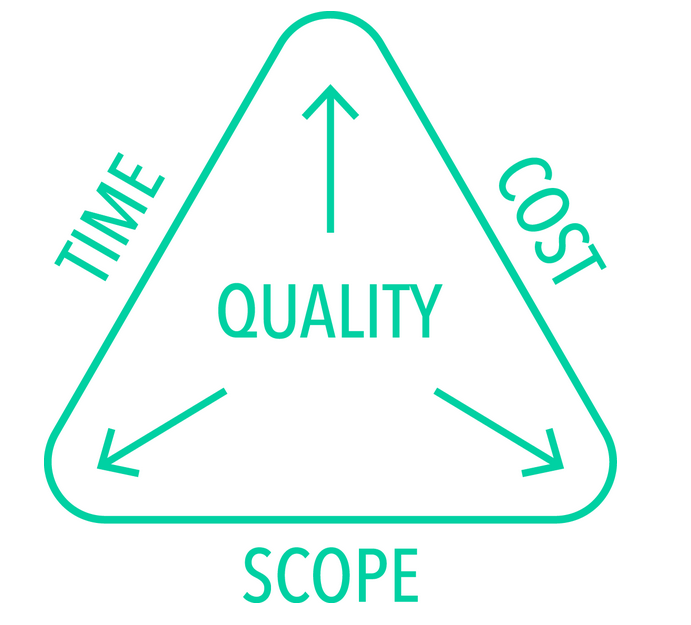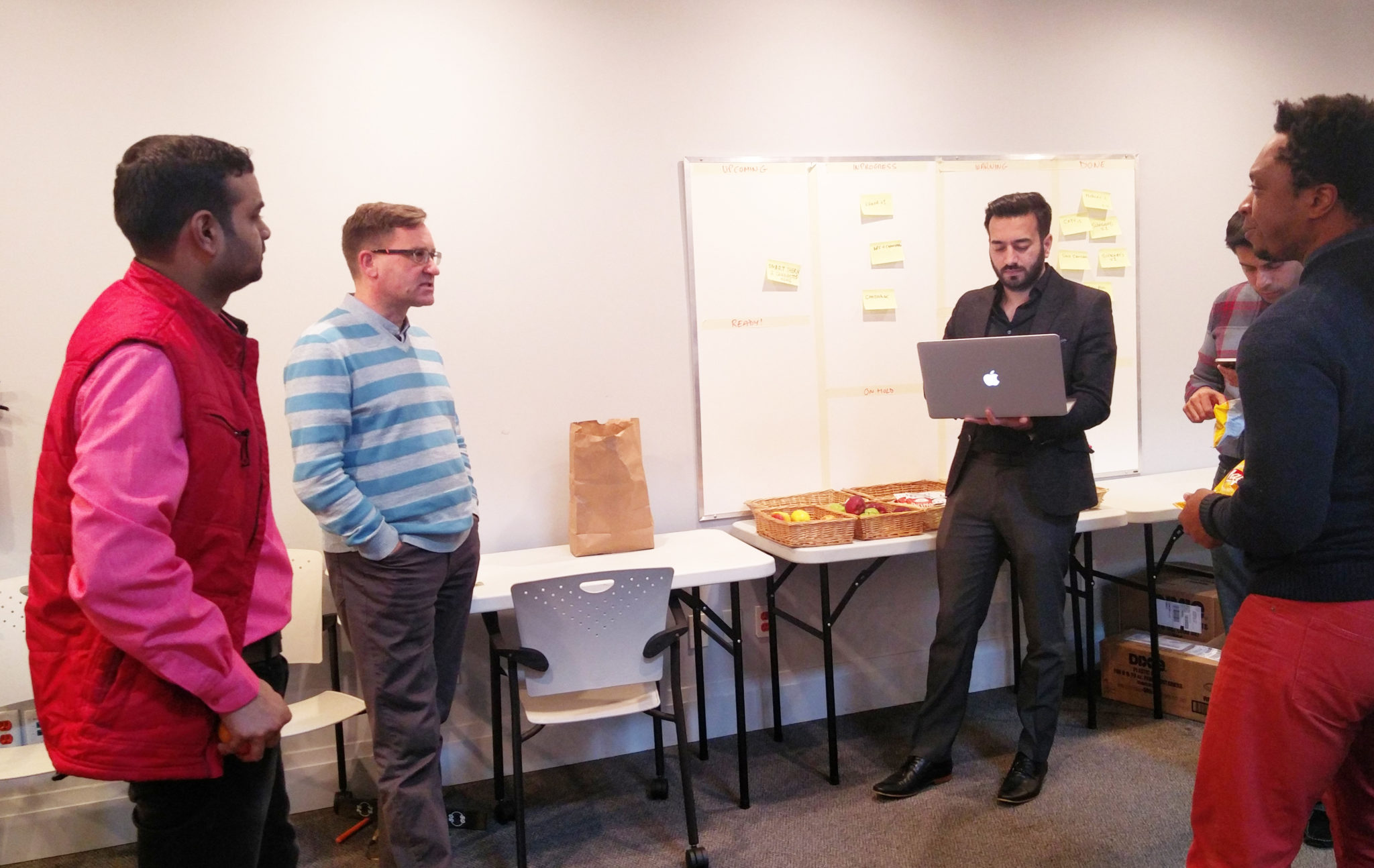Projects fail for a myriad of reasons ranging from a lack of transparency during development to shortened project deadlines. The commonality between many project failures is a lack of flexibility with project constraints.
Avoiding project failure, however, requires knowing exactly what causes the project to fail in the first place.
The project management triangle is comprised of three project constraints or boundaries: time, scope, and cost. The best product companies understand that flexibility is often required on at least one of these boundaries. As needs and objectives evolve, knowing which boundary is flexible lets you adapt seamlessly without affecting your ability to deliver a successful product.
Essentially, it’s a way of assuming the unknown and accounting for the fact that things don’t always go as planned. Achieving goals in a rapidly changing environment demands flexibility, yet that’s what many project management processes lack in mobile app development. Sticking too rigidly to an initial product roadmap and allowing the project no space to evolve could diminish the value of the final product.
Building flexibility into your process is a way to mitigate risk, which is encouraged in agile development. The key is understanding exactly where your flexibility lies.
Flexibility in Mobile App Development
“Knowing which boundary is flexible lets you adapt seamlessly without affecting your ability to deliver a successful product.”
1. Time
There are some projects where the delivery date is set in stone. The product may need to be released simultaneously with another launch; for example, a pre-loaded app that needs to be ready for the release of a new device or prior to a scheduled event. When this is the case, one of the other two boundaries will need to be flexible.
For other projects, time may not be the most important aspect. If your business goals dictate that the product needs a certain amount of features and functionalities or needs to be developed within a particular budget, time should be the flexible boundary.
Ultimately, when a schedule is shortened to meet a deadline or is too rigid for evolving requirements, the team will not function as efficiently. The quality of the delivered product will also be sacrificed due to poor processes and reduced testing. For this reason, project deadlines should remain flexible to avoid jeopardizing product quality.
2. Scope
Managing scope on projects is universally recognized as a challenge for organizations. When time or budget are rigid, scope is where the flexibility needs to lie. There is nothing wrong with having to scale back features and functionalities; going to market with a minimum viable product and following a rapid and frequent delivery model allows you to collect data and use learnings to add value to users on a continuing basis. It’s also a good way to prove concepts in the market, which can be used to create a business case for additional budget/funding from stakeholders.
A project’s processes should always be mapped thoroughly at the start and flexibility should be built into it to accommodate changes. Additional requests and added features strain resources and can affect the focus of the product vision, and without the proper controls can severely affect project success.
Agile expert Kevin Aguanno touches on this, stating that for many projects, requirements do (and probably should) change; the key to managing changes is how you react to them. In agile, changes are assessed throughout the project, with a natural break built-in before each iteration.
3. Cost
If there is scope creep or project scope increases but timeline is rigid, budget needs to become the flexible boundary. When more resources are required to deliver and as more features and functionalities are requested for the product, budget changes.
Mobile app development should use an iterative approach, which means support should be accounted for when planning a budget. The numbers may not be exact at the outset, but developing a longer-term strategy with a product roadmap (phased approach, roll-out plan for new features, etc.) will give you a good idea of the effort and resources required as requirements evolve.
Have a Contingency Plan
In an ideal world, you wouldn’t need to be flexible on time, scope, or budget. But failing to account for the fact that you might have to bend as products evolve or new needs arise is very risky; if something does change, there is no contingency plan that allows you to deliver a market-ready product.
Failing to follow agile principles and not allowing flexibility in your process means your team can’t adapt quickly. If you can’t adapt quickly, you lose project velocity, and target deadlines are missed.
Strategies For Building Flexibility Into Your Process
There are practices that allow you to bake flexibility into the agile app development process itself. These practices help with time, scope, and cost management, but also allow for rapid adaptability to changing needs. At Clearbridge, we use an agile squad model that includes a number of these practices:
- Squad-based agile development – Squads are small co-located teams that are responsible for the end-to-end delivery of a product. They plan together, share knowledge, and have a known capacity. This reduces risk and allows for predictable velocity.
- Rolling wave planning – Rolling wave planning involves delaying product decisions until you’re in the best position to make them. It lets you analyze and act upon knowledge that wasn’t available at project kick-off. This lowers your risk, minimizes downtime, and allows you to adjust to changing product needs.
- Flexible capacity – Squads have a known maximum capacity, and have the ability to scale up or down within that capacity. Since all members share knowledge of the project, when you need the squad at full capacity every team member can easily jump in; when the workload is lighter resources can be scaled down.
While there are variations in the way agile development is practiced, a foundational aspect is the ability to adapt and respond to changes without losing velocity. To achieve this, building flexibility into your mobile app development process is a necessity.
It’s crucial to stay on top of the 3 project management constraints to increase the likelihood of project success. So be cognizant of any fluctuations in changing requirements, whether they be unexpected or requested. Each of these 3 constraints are dependent on one another so prepare for fluctuations in timeline, scope, and cost.
Ultimately, flexibility allows for adaptability to changing needs and requirements without interrupting progress or harming project velocity. Identifying where your flexibility lies, accounting for it in your project plan, and building it into your development process will allow you to adapt to changes and still have the ability to deliver a successful product.








